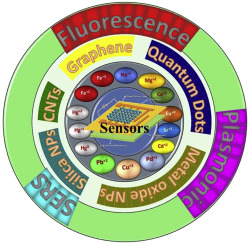Trends in Analytical Chemistry ( IF 13.1 ) Pub Date : 2018-01-12 , DOI: 10.1016/j.trac.2018.01.002 Nisar Ullah , Muhammad Mansha , Ibrahim Khan , Ahsanulhaq Qurashi

|
The anthropogenic release of heavy metals into the natural water has become a global epidemic. Heavy metal contamination poses serious threats to human health and the environment. Therefore, the development of sensors for monitoring of these toxic metals in different matrices, especially in water, is very important. As a powerful analytical tool, nanomaterial-based chemical sensors have been extensively employed for the detection of heavy metals. These nanosensors offer several advantages including high sensitivity, selectivity, portability, on-site detection ability and improved performance of devices. Moreover, the deployment of molecular recognition probe on the nanostructures for the selective binding have enhanced the selectivity and detection ability.
In this review, we critically engross on the recent progress in the design of nanomaterial-based sensors for the detection of heavy metals using various sensing strategies. The optical sensors focused and discussed in the review include fluorescent, surface enhanced Raman scattering and surface plasmon resonance sensors.
中文翻译:

用于检测水中重金属的基于纳米材料的光学化学传感器:最新进展和挑战
人为释放到自然水中的重金属已成为全球流行病。重金属污染严重威胁人类健康和环境。因此,开发用于监测不同基质中,尤其是水中的这些有毒金属的传感器非常重要。作为一种强大的分析工具,基于纳米材料的化学传感器已广泛用于检测重金属。这些纳米传感器具有许多优势,包括高灵敏度,选择性,便携性,现场检测能力和改进的设备性能。而且,分子识别探针在用于选择性结合的纳米结构上的部署提高了选择性和检测能力。
在这篇综述中,我们严格地考虑了基于纳米材料的传感器在设计中的最新进展,这些传感器使用各种传感策略来检测重金属。本文中重点讨论的光学传感器包括荧光,表面增强拉曼散射和表面等离振子共振传感器。



























 京公网安备 11010802027423号
京公网安备 11010802027423号